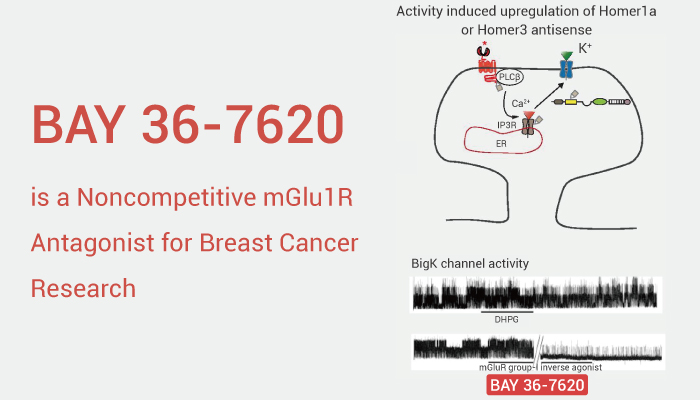Metabotropic glutamate (mGlu) receptors are G protein-coupled receptors (GPCRs) which act predominantly as modulators of synaptic transmission. Moreover, mGluRs bind with glutamate, an amino acid that functions as an excitatory neurotransmitter. As such, they play a role in many physiological and pathophysiological processes. In addition, the mGluRs perform a variety of functions in the central and peripheral nervous systems: mGluRs are involved in learning, memory, anxiety, and the perception of pain. Eight different types of mGluRs, labeled mGluR1 to mGluR8, are divided into groups I, II, and III. Receptor types are grouped based on receptor structure and physiological activity. Specifically, group I (mGlu1 and mGlu5 receptors) are coupled to the activation of phospholipase C, whereas group II (mGlu2 and mGlu3 receptors) and group III (mGlu4, mGlu6, mGlu7 and mGlu8 receptors) members are all negatively coupled to adenylyl cyclase in heterologous expression systems.

BAY 36-7620 is a potent and noncompetitive mGlu1 receptor antagonist of mGlu1 receptor with inverse agonist activity.
Studies of chimeric receptors containing regions of mGlu1 and regions of mGluA, mGlu2, or mGlu5, revealed that the transmembrane region of mGlu1 is necessary for activity of BAY 36-7620. Moreover, transmembrane helices 4 to 7 are shown to play a critical role in the selectivity of BAY 36-7620. This specific site of action of BAY36-7620 differs from that of competitive antagonists and indicates that the transmembrane region plays a pivotal role in the agonist-independent activity of this receptor. In addition, BAY36-7620 inhibits the Glu-induced activation of phospholipase C (PLC)-coupled mGlu receptors in cultured neurons. Besides, BAY 36-7620 negatively regulates the MAPK and Akt signaling pathways in melanoma cell lines, effectively inhibiting cell growth, proliferation, and invasion. In contrast, BAY 36-7620 has a more significant DNA damaging effect on breast cancer cell lines than Riluzole.
Furthermore, BAY 36-7620 inhibits tumor growth and prolonged survival of mice with tumors of A549 or H1299. Pre-treatment with BAY36-7620 blocked the VEGF-induced AKT phosphorylation in HUVECs.
To sum up, BAY 36-7620 is a potent and noncompetitive mGlu1 receptor inverse agonist with anticancer and neuroprotective effects.
References:
[1] Carroll FY, et al. Mol Pharmacol. 2001 May;59(5):965-73.
[2] Xia H, et al. Eur J Pharmacol. 2016 Jul 15;783:103-11.
[3] Dolfi SC, et al. Oncotarget. 2017 Jul 4;8(27):44639-44653.